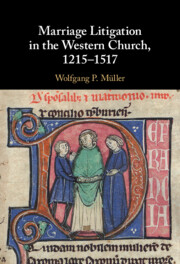24 results
17 - Procedures and Courts
- from Iudicium
-
-
- Book:
- The Cambridge History of Medieval Canon Law
- Published online:
- 13 January 2022
- Print publication:
- 27 January 2022, pp 327-342
-
- Chapter
- Export citation
5 - The Reinvention of Canon Law in the High Middle Ages
- from Part I - The History of Medieval Canon Law
-
-
- Book:
- The Cambridge History of Medieval Canon Law
- Published online:
- 13 January 2022
- Print publication:
- 27 January 2022, pp 79-95
-
- Chapter
- Export citation
Bibliography
-
- Book:
- Marriage Litigation in the Western Church, 1215–1517
- Published online:
- 03 September 2021
- Print publication:
- 16 September 2021, pp 246-263
-
- Chapter
- Export citation
Copyright page
-
- Book:
- Marriage Litigation in the Western Church, 1215–1517
- Published online:
- 03 September 2021
- Print publication:
- 16 September 2021, pp iv-iv
-
- Chapter
- Export citation
Acknowledgments
-
- Book:
- Marriage Litigation in the Western Church, 1215–1517
- Published online:
- 03 September 2021
- Print publication:
- 16 September 2021, pp vii-viii
-
- Chapter
- Export citation
Appendix – Sentencing in Select Diocesan Registers
-
- Book:
- Marriage Litigation in the Western Church, 1215–1517
- Published online:
- 03 September 2021
- Print publication:
- 16 September 2021, pp 218-245
-
- Chapter
- Export citation
Conclusion
- from Part II - The South
-
- Book:
- Marriage Litigation in the Western Church, 1215–1517
- Published online:
- 03 September 2021
- Print publication:
- 16 September 2021, pp 215-217
-
- Chapter
- Export citation
Chapter 3 - England
- from Part I - The North
-
- Book:
- Marriage Litigation in the Western Church, 1215–1517
- Published online:
- 03 September 2021
- Print publication:
- 16 September 2021, pp 84-114
-
- Chapter
- Export citation
Chapter 2 - Franco-Germanic Adjudication
- from Part I - The North
-
- Book:
- Marriage Litigation in the Western Church, 1215–1517
- Published online:
- 03 September 2021
- Print publication:
- 16 September 2021, pp 55-83
-
- Chapter
- Export citation
Index
-
- Book:
- Marriage Litigation in the Western Church, 1215–1517
- Published online:
- 03 September 2021
- Print publication:
- 16 September 2021, pp 264-270
-
- Chapter
- Export citation
Chapter 6 - The Domestic Partnerships of Iberia
- from Part II - The South
-
- Book:
- Marriage Litigation in the Western Church, 1215–1517
- Published online:
- 03 September 2021
- Print publication:
- 16 September 2021, pp 183-214
-
- Chapter
- Export citation
Introduction
-
- Book:
- Marriage Litigation in the Western Church, 1215–1517
- Published online:
- 03 September 2021
- Print publication:
- 16 September 2021, pp 1-20
-
- Chapter
- Export citation
Part I - The North
-
- Book:
- Marriage Litigation in the Western Church, 1215–1517
- Published online:
- 03 September 2021
- Print publication:
- 16 September 2021, pp 21-114
-
- Chapter
- Export citation
Chapter 4 - Italy: Canonical Marriage on the Sidelines
- from Part II - The South
-
- Book:
- Marriage Litigation in the Western Church, 1215–1517
- Published online:
- 03 September 2021
- Print publication:
- 16 September 2021, pp 117-149
-
- Chapter
- Export citation
Part II - The South
-
- Book:
- Marriage Litigation in the Western Church, 1215–1517
- Published online:
- 03 September 2021
- Print publication:
- 16 September 2021, pp 115-217
-
- Chapter
- Export citation
Illustrations
-
- Book:
- Marriage Litigation in the Western Church, 1215–1517
- Published online:
- 03 September 2021
- Print publication:
- 16 September 2021, pp vi-vi
-
- Chapter
- Export citation
Chapter 1 - Matrimonial Caseloads in Xanten and Basel
- from Part I - The North
-
- Book:
- Marriage Litigation in the Western Church, 1215–1517
- Published online:
- 03 September 2021
- Print publication:
- 16 September 2021, pp 23-54
-
- Chapter
- Export citation
Contents
-
- Book:
- Marriage Litigation in the Western Church, 1215–1517
- Published online:
- 03 September 2021
- Print publication:
- 16 September 2021, pp v-v
-
- Chapter
- Export citation
Chapter 5 - Top-Down Pastoral Action in Catalonia
- from Part II - The South
-
- Book:
- Marriage Litigation in the Western Church, 1215–1517
- Published online:
- 03 September 2021
- Print publication:
- 16 September 2021, pp 150-182
-
- Chapter
- Export citation

Marriage Litigation in the Western Church, 1215–1517
-
- Published online:
- 03 September 2021
- Print publication:
- 16 September 2021



